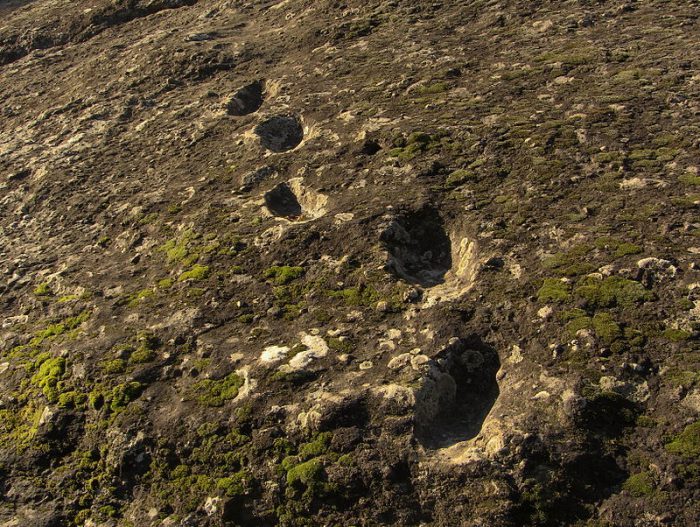On the slopes of Roccamonfina—a long extinct volcano in Campania, Italy—there are a series of tracks in the rock. For centuries, locals have called them Ciampate del Diavolo—meaning Devil's Footprints in Italian.
Dating back to 350,000 years ago, they have mystified researchers for years. Specifically, who made them? And how?
After all, we're talking about the side of a volcano here! To have left these tracks in igneous (volcanic) rock, these footprints would've had to have been made very soon after an eruption—before the fresh lava had fully cooled into stone. Yikes!
Now a new study claims that whatever species left these tracks, some of them were actually walking back up the mountain after an eruption!
Tracking the tracks

Whoever left the tracks, they would've had to have stepped through recently flowing lava to do it! (Wikimedia Commons)
In total, there are about 81 tracks on the slopes of Roccamonfina. Sixty-seven of them appear to go down the mountain side—these are collected into three sets of tracks. But then there are a more recently studied group of 14 tracks that appear to go uphill.
These tracks are the most amazing because they suggest that whomever left them was not trying to flee the recent eruption. They were trying to get closer and check it out!
Why would anyone do that? It sounds like a bad idea at first, until you think of all of the daring things that human explorers do. Perhaps this is just an ancient example of the curiosity that makes humans, well, human!
But that brings up another question: Were these tracks actually left by humans?
Ancestral trails

A comparison of skulls between humans (Homo sapiens, left) and Neanderthals. Neanderthals are a possible species that left these tracks. (Wikimedia Commons)
For starters, these definitely were not Homo sapien tracks. They are simply too old for that. (The earliest Homo sapiens—a.k.a. us!—evolved in Africa around 315,000 years ago.)
But they definitely were left behind by some early human ancestors. Over the years, studies have suggested that they could be Homo heidelbergensis, Denisovan, or Neanderthal. These were all important parts of the evolution that eventually led to modern humans ... and not devils (sorry, diavolos!).
According to the most recent studies, researchers don't feel comfortable pinning the prints to an exact species just yet. And they may never—the tracks are simply too old and too 'rough' to make such a claim. But knowing that the ancestors who made these tracks were climbing a hot volcano still paints a really fascinating picture.
Whoever they were, they were definitely brave!
 The fascinating footprints of Ciampate del Diavolo. (Wikimedia Commons)
The fascinating footprints of Ciampate del Diavolo. (Wikimedia Commons)









